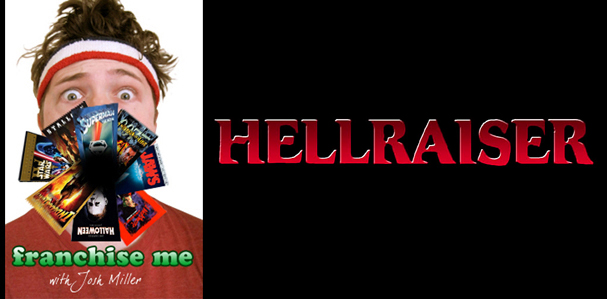
Hollywood loves a good franchise. The movie-going public does too. Horror, action, comedy, sci-fi, western, no genre is safe. And any film, no matter how seemingly stand-alone, conclusive, or inappropriate to sequel, could generate an expansive franchise. They are legion. We are surrounded. But a champion has risen from the rabble to defend us. Me. I have donned my sweats and taken up cinema’s gauntlet. Don’t try this at home. I am a professional.
Let’s be buddies on the Facebookz!
The Franchise: Hellraiser — concerning a supernatural puzzle box (and those humans foolish/unlucky enough to solve it) that opens a doorway to the hellish dimension of Pinhead, the most prominent member of the Cenobites, powerful beings who desire human souls for sadomasochistic experiments. Adapted from Clive Barker’s novella The Hellbound Heart, the franchise spans nine films, from 1987 to 2011.
previous installments
Hellraiser
Hellbound: Hellraiser II
The Installment: Hellraiser III: Hell on Earth (1992)
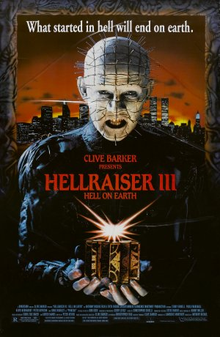
The Story:
Last we left Pinhead, he had become entombed (or whatever) inside the S&M decorated column that rose up from the bloody mattress in Hellraiser II‘s epilogue. Now that column is living in an art gallery where it is spotted by rich playboy J.P. Monroe (Kevin Bernhardt), who ads the piece to his personal collection and inadvertently awakens Pinhead when he drips blood on the column. Meanwhile, we meet our new hero, a frustrated yet plucky TV journalist named Joey Summerskill (Star Trek: Deep Space Nine‘s Terry Farrell), who stumbles upon the Hellraiser mythology when she witnesses a man torn apart by Cenobite chains in an emergency room while on a mundane assignment. Now obsessed, Joey tracks down a girl she saw in the emergency room, Terri (90’s hottie Paula Marshall), to J.P.’s club. Long story short, using J.P., Pinhead manages to free himself from the column and replace his entourage of Cenobites. Now he wants to take over the world. Or something.
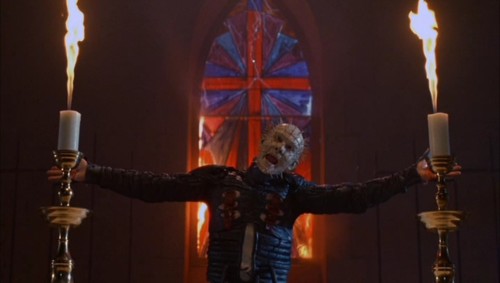
What Works:
Ignoring for the moment how well it relates to the existing conventions and mythos of the franchise, Hellraiser III is actually the most technically competent of the first three films. For once we have a clear-cut Hero (Joey) with a goal that organically evolves with and more importantly drives the film towards a clear-cut finale. Its strength is its typical formula. It is also the first Post-Pinhead Revelation film in the franchise; ie, the first film made after the powers that be realized that audiences loved Pinhead and didn’t really give a shit about Julia or Frank or even Kirsty. Misguided as some of the conclusions screenwriters Peter Atkins, Tony Randel and director Anthony Hickox take away from this realization may be, viewed on its own terms the film functions well as a piece of horror entertainment. Had this been an original film, I think the much-hated themed Cenobites that Pinhead creates out of our supporting characters would be considered one of its strengths, something audience members would look forward to in sequels. Conceptually it is an amazing idea for an on-going villain modus operandi; like the Pimp My Ride of horror movies. I mean, come on… Bartender Cenobite carries a martini shaker for godsake! That’s some hilarious shit right there.
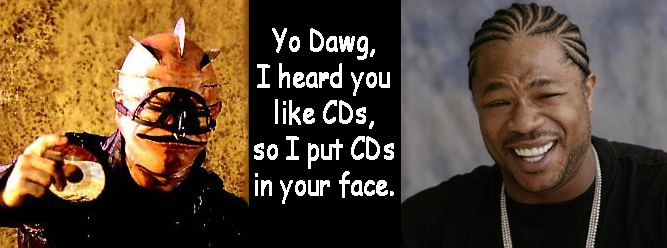
I am a fan of Anthony Hickox (Waxwork, Sundown: The Vampire in Retreat). His strengths are infusing light weirdness and whimsy into his horror, which makes him an illogical choice for the steamy, kinky, baroque world of Hellraiser. But, again, if we view the film on its own terms, Hickox delivers on the promise of Anthony Hickox directing a Pinhead movie (though one could say its a threat, not a promise). Hickox gives us some great set pieces. The early emergency room scene in which Joey sees the puzzle box’s first victim eerily exploded by chains while lying on a gurney is really well staged, and probably the only moment in the entire film that feels like it could have been in either of the first two films. I also really like the scene in which Pinhead (still trapped in the column) attacks and kills the stupid bimbo that J.P. had brought up to his suite for a boning session. When I was younger and unable to really keep any of the Hellraiser films apart in my mind, that was one of the more indelible moments; one I was later surprised was in this lesser film, and not 1 or 2. Also, Hickox grasps the notion of escalating tension in a way that Barker and Tony Randel didn’t. This is most represented in the detective work that Joey and then Joey and Terri do while tracking down the mystery off the Pinhead column that J.P. bought. For contrast, in Hellraiser 2 Kirsty “figures out” Pinhead’s backstory simply by finding a picture of Captain Eliot Spencer (aka, Pinhead’s original human form) and improbably recognizing him as Pinhead, even though Doug Bradley’s entire face shape looks completely different with all the make-up appliances on. Narratively, I enjoyed the element of Hero problem solving here, even though we already know the backstory ourselves.
I find J.P. an entertaining sub-villain, and variation on Frank — owning his own douche club, living on the top floor where the Pinhead column is kept and where he brings partygirls to bone. The sex and hedonism here are perfect ingredients for the franchise. Plus, any character the smokes while having sex gets a thumbs up from me. I also like the idea of Pinhead trapped in the column, with only his face poking out, seducing J.P. with only words. The film could’ve used a few more such ideas, even if they don’t make sense (that’s in keeping with the franchise, after all). The only other fun Hellraiser idea comes at the very end, after Joey sinks the puzzle box into the wet cement of a construction site. Then we cut to later, and the finished building is decked out in Lament Configuration designs. This doesn’t really make any sense, but whatever, it’s cool.
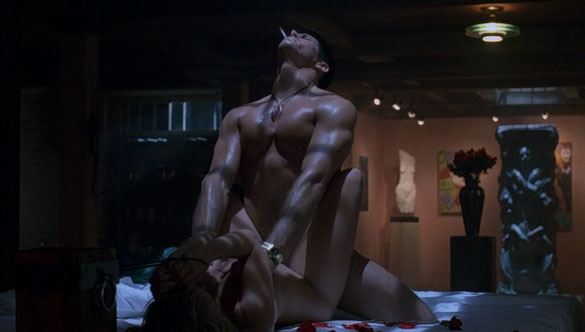
What Doesn’t Work:
Hellraiser III reveals the crippling paradox at the heart of the Hellraiser franchise. Talk to any fan of the first film, and they are pretty much guaranteed to say that their favorite thing about the Cenobites (and Pinhead) is that they are neither good nor evil and play a secondary role in the film. Yet, they will surely also say that the best thing about the film overall is the Cenobites (and Pinhead). So… where does one really go from there, in a longterm franchise sense? How many films can we have where Pinhead is kept a detached peripheral character? Barker and co. tried to follow through with this logic by getting rid of Pinhead and moving Julia, who was not detached or impartial, into the Big Bad role. But the customer is always right, and the customers loved Pinhead. They were pissed he got killed. They wanted more. And Hellraiser III is the very embodiment of needing to be careful what you wish for. Realistically, I don’t think there was a way to successfully develop the structure of Hellraiser into a model that was easily replicated film after film, but things didn’t need to go so wrong so fast. My biggest gripe with Hellraiser III isn’t that they promoted Pinhead to the Big Bad, but that they completely changed the character and nature of the franchise’s mythos in doing so.
Just looking at the character of Pinhead, everything about him is different now. He used to be rigid and stoic. Now he not only smiles constantly, but laughs a lot too. He went from being emotionally distant, to a merry prankster edging towards Freddy or the Leprechaun; he is taking great delight in his evil mischief. You half expect him to break the fourth wall and give a wacky aside to the camera after doing something particularly devilish. We know we’re in trouble during Pinhead’s first scene, when J.P. shoots him with a handgun, and Pinhead spits the bullets out of his mouth. Ugh. Even from a technical perspective the character is different and wrong. In the first two films Doug Bradley’s voice was pitched down, giving Pinhead’s brilliant dialogue a bombastic and otherwordly quality. Now we’re basically just listening to Bradley doing a voice. The inflections are the same, but as was also the case with Robert Englund’s Freddy, when you hear him doing it without the pitching, the lines lose a lot of their impact.
We’ve also gone completely down the evil rabbit hole now. There is no more ambiguity to Pinhead. He is straight up evil. The film sort of plays at an explanation with the Captain Elliot Spencer character, who is guiding Joey via dreams to defeat Pinhead. He explains that he and Pinhead have been separated, and now Pinhead is unbalanced. “My evil was too strong.” There is a Good Kirk/Bad Kirk element here, if you really want to look for it, but it doesn’t work for me — particularly because it doesn’t help explain Pinhead’s demeanor or motivations any better. If anything, devoid of Spencer, Pinhead should be even more detached. He should be a Dr. Manhattan gone horribly wrong, a powerful force lacking in human emotions and desires, carrying out a purpose with no relatable motive. Pinhead’s powers are vastly different as well. Previously it seems that Pinhead didn’t really have “powers” exactly. The puzzle box opened a doorway, through which he walked. Then he could summon his chains. Now Pinhead is powerful enough to create a fake news broadcast that Joey sees on her TV. That is some straight-up Freddy shenanigans right there. None of this is actually an evolution of what people liked about the first two films, but simply game changers to make the franchise more suitable to repetition now that Miramax bought it. The shift away from the previous two films is possibly most easily summed up in the body count stats. III has by far the most kills, but not a single one of those kills is human on human violence. Pinhead or the other Cenobites do all the killing. Conversely, in Hellraiser the Cenobites’ only victim is Frank. All the other kills are committed by Julia and Frank.
It had already bugged me in the previous films how easy it was the solve the puzzle box when the scene necessitated it. Hellraiser III tries to retcon an explanation here, when Kirsty (in her cameo) says that the puzzle box wants to be solved, that it guides your hands to open it. This makes a certain amount of sense, and I understand why they incorporated this explanation, but it just further separates us from the amazing ideas Barker created in Hellbound Heart and the first film. I loved the idea that people scoured the globe to find these puzzles boxes, and worked for days, weeks, months, maybe even years to try and open it. That’s what made the horrors of the “reward” so demented. Now, like Pinhead, the puzzle box is just evil. It tricks you, essentially, which isn’t as cool of an idea. But even this new explanation has one huge logic hole — why is it so easy for Joey to transition the puzzle box into its final configuration, that sends Pinhead back to Hell? Does the puzzle box want that too? Cause that doesn’t make sense. Kinda seems like it should be fighting her.
Speaking of Captain Elliot Spencer, while it is always nice for a buried-in-make-up actor to get to show his face in a sequel, there is just too much Spencer in III. That the film climaxes in a battle between Spencer and Pinhead was probably more interesting on paper than it is to watch. I also don’t like the characterization we get of Spencer here, as he is so good and pure that he doesn’t seem in keeping with the two previous examples we’ve had of puzzle box aficionados (Frank and Channard). Again, this could be chalked up to the Good Kirk/Bad Kirk thing, but whatever. It is boring, regardless. Frankly, though, I might have liked seeing Spencer more if he wasn’t always tied in with Joey’s lame Vietnam nightmares subplot, in which she dreams about her father dying during the war. It is pretty hokey.
Joey is a better constructed protagonist than Kirsty (in a generic sense), and Terry Farrell is a better actress than Ashley Laurence. That said, Joey isn’t such a great Hero either, for two simple reasons: 1) she is a journalist. Journalists make for tricky movie heroes, because there is such a blatant blurred line between pursuing a story to “expose the truth” and doing so to further the journalist’s career. This is why journalists make great complex heroes. The problem only arises when they aren’t supposed to be complex, like Joey. We’re supposed to feel like Joey is trying to unravel the mystery of the man she saw die in the emergency room for our sake, not her own. But this is undermined by her very first scene, in which she intentionally fucks up her news coverage because she feels the assignment is so stupid and unimportant. She wants to be telling the big stories. That’s a realistic, but self-serving attitude. 2) she is rather stupid. I liked the detective work phase of the film, but Joey doesn’t come across as very savvy or good at it. Really she just gets lucky a lot. In the scene where she enters J.P.’s club, she approaches J.P. to get help tracking down Terri. When J.P. flirts with Joey, she says, “I’m not your type. I’m out of grade school.” What kind of moron insults the person they’re trying to get help from? J.P. was barely flirting with her too; it’s not like he was being so gross that we could sympathize with Joey’s desire to drop her act and tell him off. She had no act. Shouldn’t she use her hotness to get J.P. to do what she wants?
And of course we can’t forget our new Cenobites, who are truly impressively stupid. As I said before, if the film is viewed on its own terms, the new Cenobites are so stupid that they’re quite wonderful, but viewed as a new tweak to the franchise they’re an abomination. Channard was the first new Cenobite we saw created, and like the other Cenobites, his design was fevered nonsense. I’m not even sure how to describe his design in a succinct way. There was a very vague thematic connection between elements of his design and his personalty, as he was able to produce tentacles from his finger tips that could flower into scalpel blades, and he had lines like “The doctor is in.” But if Channard had been in III he would’ve had one of those old-fashioned headband mirror discs that doctors used to wear poking out of his forehead or an x-ray machine in his chest or something equally cartoonish, and his one-liners would’ve been endless. He would’ve murdered someone with an apple, and then said, “An apple a day keeps the doctor away.”

Overall Body Count: 18 on-screen, plus another 100 or so implied off-screen.
Souls Torn Apart By Cenobites: Ditto.
Best Kill: When CD-Face Cenobite ninja-stars a CD into a dude’s head. Ahahahahaaha. Gold.
Best Cenobite That Isn’t Pinhead: CD-Face Cenobite. All the way.
Best Badass Pinhead Line: “Down the dark decades of your pain, this will seem like a memory of Heaven.”
Best Whimsical Pinhead Line: “I’m going to enjoy making you bleed. And I’m going to enjoy making you enjoy it.”
Stupidest Cenobite One-Liner: After Bartender Cenobite blows up some cop cars and cops. Camerahead Cenobite: “That’s a wrap.”
Most Unpleasant Moment: Watching J.P. super-thrust during his sex scene.
Should There Have Been a Sequel: Eh, damage has been done. Whatever. Let’s get some more Pimp My Ride Cenobites.
For Funzies: For Franchise Me fans who live in Los Angeles, you will (hopefully) be excited to learn that – inspired by Franchise Me – Sebastian O’Brien and I are doing an expanded version of our Friday Night Frights screening series all month long dedicated to horror franchises. Relevant here is the fact that we’re doing Hellraiser 1, 2, 3 on Oct. 20. If you live in the LA area, like Friday Night Frights on Facebook to get more info about the show.
But even if you don’t live in LA, you can still enjoy the trailer for the event that I made.
..
Up Next: Hellraiser: Bloodline
previous franchises battled
Critters
Death Wish
Leprechaun
Phantasm
Planet of the Apes
Police Academy
Rambo
Tremors